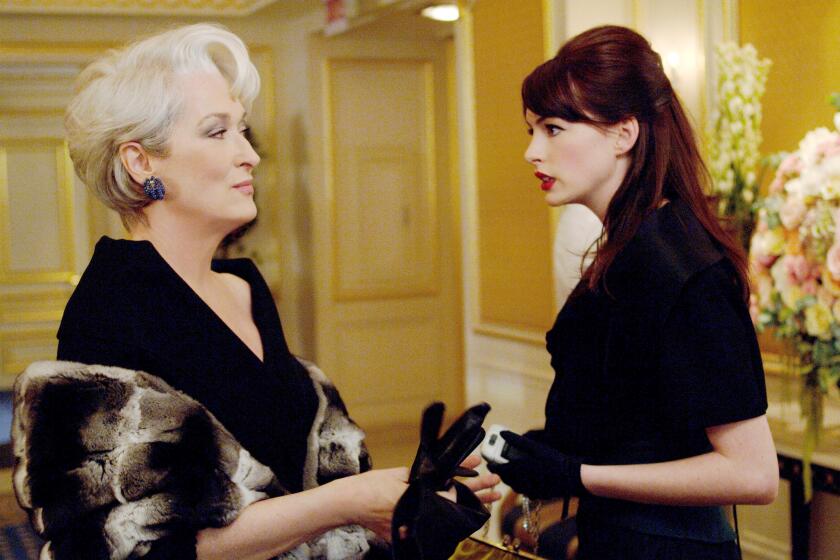‘My Left Foot’ a First Film That Wins Respect for Its Makers : Movies: For $3 million, a novice producer and director pull together the story of an Irish artist crippled by cerebral palsy.
- Share via
The movies--individually and as an industry--have not lost their capacity to surprise. Few would have predicted a year ago that a film about an autistic savant would dominate the critics’ awards and then the Oscars.
Even fewer, I suspect, would have predicted that a film about a severely crippled cerebral palsy victim would win honors from the critics’ groups this year and could well show up in the Academy Award nominations Feb. 14. “My Left Foot,” drawn from the autobiography of the extraordinary Dubliner Christy Brown, was named best picture by the New York Film Critics Circle, and its star, Daniel Day-Lewis, has been voted best actor by both the New York and Los Angeles critics.
Day-Lewis’ portrayal of a man who, because of cerebral palsy, could control only his left foot and speak only in a side-of-the-mouth slur, is one of the year’s tour de force performances. It is likely to go to the wire in the Oscar sweepstakes with Tom Cruise’s powerful role as paraplegic Ron Kovic in “Born on the Fourth of July.”
The accolades for “My Left Foot” are particularly pleasing to Noel Pearson, who conceived and produced the film, which was made for the remarkably small sum of $3 million. It was the first film for Pearson, who had been an agent and later a producer of stage musicals, including a revival of “Pinafore” that had a long run in Dublin and elsewhere. He is presently the artistic director of the Abbey Theatre.
The film’s early successes are pleasing as well to Jim Sheridan, who directed “My Left Foot” and co-authored it with Shane Connaughton. An actor turned writer and stage director, Sheridan had never done a film either.
Pearson, Sheridan and their star were in Los Angeles last week in behalf of the film, with the bulk of the media attention falling inevitably on Day-Lewis. “He’s been on the road for the film for eight months,” Pearson says, “a producer’s dream. I only worry that he never relaxes, never lightens up.”
Remembering Brown, Pearson says, “He was always falling in love. He’d fall in love with a woman across the room in a restaurant and send her a note. He’d write love poems to the girls in my office.”
Brown, he says, also had an eclectic musical taste that ran from Mozart to Van Morrison. He read voraciously and was especially fond of the novels of Thomas Wolfe. “He had a wild, dark sense of humor and an enormous capacity for drink.”
(The film ends at a high point, just as Brown meets the nurse he was to marry. The last years were in fact sad; the drinking got out of hand and he died at only 49.) Pearson had tried 10 years ago to get a film going on Brown’s book “Down All the Days,” but couldn’t find backing. He then bought the rights to “My Left Foot” and at the end of 1987 asked Connaughton and Sheridan, whom he’d met in New York, to do a script.
“I’m a bit amazed at the concept of the producer here,” Pearson says. “The impression is he’s a man with a checkbook and a platinum American Express card. Nothing to do with the creative end of things at all. I can’t accept it.”
Meantime, Pearson had met Day-Lewis at a party in Dublin for composer Elmer Bernstein (who later wrote the score for “My Left Foot”). “I told him all about Christy Brown,” Pearson says, “and he was riveted. But I thought he was riveted with boredom and just being polite. He’s forever polite.”
The actor’s career was on a sharp-rising curve--”Room With a View,” “My Beautiful Laundrette,” “The Unbearable Lightness of Being”--and Pearson had no thought that he would consider playing the part. But when Day-Lewis finally saw a script, he said, “Why didn’t you offer this to me six months ago?”
Day-Lewis carries an Irish passport, his father, the late poet laureate of England, C. Day-Lewis, having been born in Ireland. It helped with the film financing. Pearson recruited most of the backing for the film from Granada Television in London, which was getting into film financing. Further funds were obtained by executive producer Paul Heller, whose credits range from “David and Lisa” to “First Monday in October.”
Although it was Sheridan’s first film script, he’d written plays and had directed in the theater for nearly 20 years. He formed an experimental theater group called The Project in Dublin, then ran afoul of the city fathers with a production called “The Gay Sweatshop.”
“Lost our grant and our theater,” he says. “I thought we’d be sly and move just over the line into the next borough. But the corporation (city council) didn’t like us there either. They issued a grand statement saying there was to be no representation of homosexuals, heterosexuals or lesbians on the stage. I said, ‘Well, that pretty much leaves us with animals,’ and I also told myself I’d best get out, so I went to New York.”
Sheridan and Pearson have just finished shooting a second project, “The Field,” with Richard Harris and Tom Berenger, adapted from a play and set in the west of Ireland. “It’s an Irish Western, I suppose,” Pearson says. “Very powerful.”
Berenger plays an American who buys a piece of land that the sitting tenant had presumed was his by right. Murder follows, and an examination of the morality of land.
It is apt to have very respectful attention in Hollywood. Someone else’s success, like hanging, concentrates the mind wonderfully.
More to Read
Only good movies
Get the Indie Focus newsletter, Mark Olsen's weekly guide to the world of cinema.
You may occasionally receive promotional content from the Los Angeles Times.










